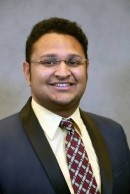
Chakraborty Presents amongst Leading Women in Tech
Suryadip Chakraborty,
College of Engineering and Applied Science
computer science doctoral student, will present at the 2015 National Grace Hopper Celebration (GHC) of Women in Computing in Houston, TX on October 15, 2015. The years GHC theme
most accurately depicts the largest gathering of women technologists from across the globe. The number of women in computing is steadily increasing over recent years. In 2013, 26% of the computing workforce were women, and the National Center for Women & Information Technology predicts 1.2 million computing-related job openings in the U.S. by 2022.*
At the 2015
, Oct. 14-16, in Houston, TX, esteemed computing leaders will present groundbreaking research including Susan Wojcicki, CEO of YouTube; Moira Forces, President and Publisher of ForbesWoman and Executive VP of Forbes Media; and Chelsea Clinton, Vice Chair of the Clinton Foundation.
On October 15 from 2:30 p.m.3:30 p.m., CEAS
student,
, will present his doctoral research on wireless body area networks and performance analysis, also sharing why he believes in harnessing the great potential computer science brings towards interconnecting diverse individuals of all genders, races and religions. Chelsea Clinton will present on,
Fixing the Leaky Pipeline: Unleashing the Power of Community,
directly after Chakraborty.
His research focuses on the increased demand for novel, real-time health monitoring systems in the healthcare industry, specifically on body area networks (BAN). BAN are capable of continuously monitoring and measuring unique physiological body parameters, such as heart rate, blood pressure and electrocardiogram (ECG) signals. BAN can be applied in a myriad of situations, such as monitoring Parkinsons disease patients health data, collegiate athletes injuries, firefighters real-time health data, as well as could-based health data technologies. Chakrabortys advisor, Dharma Agrawl, PhD and professor for the
Department of Electrical Engineering and Computer Science (EECS)
assisted in Chakrabortys various applications of BAN monitoring.

Suryadip (left) and James Benjamin Peake, 6th U.S. Secretary of Veterans Affairs (middle), at 2015 HIMSS Conference in Chicago, IL
Chakraborty obtained a B.Tech (Bachelor of Technology) from
St. Thomas College of Engineering and Technology
, in affiliation with the
West Bengal University of Technology
in Kolkata, India. He received his MS in computer science at the University of Cincinnati
College of Engineering and Applied Science
in 2013.
Chakraborty speaks on behalf of his diverse research and experience working with leading female IT professionals at companies such as Google, Apple and Intel. During the summer of 2015, he mentored two women from elite Indian universities as a part of the
, furthering his dedication towards advancing women in computing and technology.2 His strong belief in the collaborative power gender equality and diverse leadership in the computing industry speaks for itself, One of the greatest challenges in 21st century technology and IT is overcoming gender inequality. My technical talk at Grace Hopper is focused on increasing the awareness of using computer science and technology to monitor and improve human health, and I hope to inspire more female students to consider utilizing such advances in their own research. From my experience at top U.S. IT companies and academic institutions, I have come to realize the inherent intellectual strength in both women and men, and we achieve the best results when both genders participate equally, says Chakraborty. He notes that his parents and older brother, Subhadip Chakraborty, are his core inspirations behind his journey as a technology researcher and aspirant leader in IT.

Suryadip presenting at 2013 IEEE DCOSS Conference in Boston, MA
In addition to his remarkable research accomplishments thus far, Chakraborty currently serves as the poster and student contest track chair for the 2015
. He also holds several international peer-reviewed conference and journal publications, as well as one patent:
- Suryadip Chakraborty, Performance Analysis in Wireless Body Area Network, Doctoral Consortium, ACM Tapia Conference 2015, Boston, USA, Feb 21, 2015.
- Suryadip Chakraborty, Saibal Ghosh, Anagha Jamthe, Dharma P Agrawal, Robert Mangine, Angelo Colosimo and Joe Rauch, Quantitative Assessment of Functional Movement Screen in Athletes using a Wireless Body Area Sensor Network, International Congress of Sports Science Research and Technology Support (icSPORTS 2013), 20-22 September, 2013, Vilamoura, Algarve, Portugal.
- Sivaramakrishnan Vaidyanathan, Suryadip Chakraborty and Dharma P. Agrawal, "Efficient reorganization of a multi-hop wireless body area network," AshEse Journal of Engineering, Vol. 1(2), pp. 008-015, June, 2015, © 2015 AshEse Visionary Limited.
The College of Engineering and Applied Science wishes Suryadip enduring prosperity in his research and career journey in computing science and additionally the best of luck as he prepares to present his doctoral research at the 2015 Grace Hopper Celebration of Women in Computing in Houston, TX.
Related Stories
Biomedical engineering student contributes to cancer research
September 18, 2024
University of Cincinnati PhD student Maulee Sheth has been named Graduate Student Engineer of the Month by the College of Engineering and Applied Science. A biomedical engineering student, she works in the Esfandiari lab on cancer tumor microenvironment research to better understand the disease. Through her time here, she has collaborated with researchers at Cincinnati Children's Hospital and the UC College of Medicine.
UC welcomes 10 new engineering faculty this fall
September 17, 2024
The University of Cincinnati welcomed ten new faculty members in the College of Engineering and Applied Science in mechanical engineering, industrial & systems engineering, computer science, electrical engineering, aerospace engineering, and engineering education.
Ohio Cyber Range Institute receives $6.5M in state funding
September 12, 2024
The Ohio Cyber Range Institute (OCRI) at the University of Cincinnati will receive $6.5 million in capital budget funds from the State of Ohio, news outlets such as the Cincinnati Business Courier reported.
